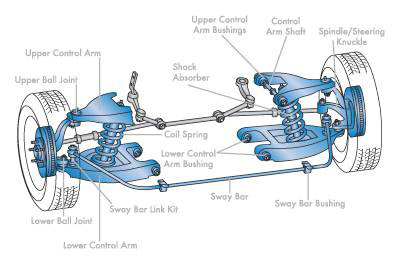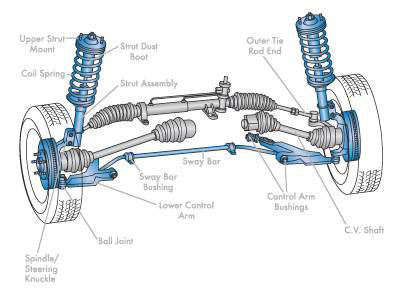Car Care - About Steering & Suspension
When it comes to absorbing the shocks of the road, you'd think the shock absorbers would take care of everything. But you'd only be half right. Actually, coil or leaf springs handle the abuse of the road. Your shock absorbers handle the abuse caused by the rebound of the springs. They both work together to keep your vehicle under control. Those two components, plus a variety of control arms, shafts, rods, bushings, joints, and knuckles, make up what is commonly called a conventional suspension. Many larger SUVs and pick up trucks still use this time-tested design.

However, many of today's front-wheel drive cars have a strut suspension system that combines the control arms and shock absorbers of a conventional suspension into one unit, eliminating the need for a lot of other components. Struts cost more, but they do more than conventional shock absorbers. Also, there's less stuff to break.

No matter what kind of suspension you have, its operation is affected by your car's alignment, which determines everything from the position of your steering wheel to how your tires actually touch the road.
What to Watch For
Here are a few symptoms to watch for if you think you are having steering, suspension, or alignment problems.
Excessive tire wear, poor steering control, or if the steering wheel is off centre, are all signs that your vehicle may have steering or suspension issues. It could also indicate improper “tracking” that result from your car's wheels being positioned an unequal distance from the centerline.
Symptoms of bad shocks, struts, or worn springs include excessive bouncing over road bumps, loss of control during sudden stops, excessive swerving while changing lanes, front-end nose diving during quick stops, and vehicle sag in front or rear. If you experience any of the above, bring your vehicle to our shop for an alignment inspection or steering or suspension inspection.